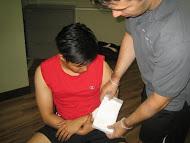
The medical term ‘wound’ refers to an injury where the skin has been torn, cut, or punctured. When this happens on internal tissues, it is called a closed wound. However, we use the phrase ‘open wound’ to refer to a break on the skin or mucous membrane of the body. This article will elaborate more on first aid for open wounds.
Types of Open Wounds
There are different types of open wounds that might occur. These injuries are classified according to the object that caused them. Here are the different types of wounds according to classification.
Puncture Wounds: These result from a sharp object that punctures the skin such a nail, thorn or splinter.
Gunshot Wounds: Usually, bullets cause what is called a ‘through-and-through gunshot wound. This means that there are two wounds, one at the entry site and the other at the point of exit.
Incisions: Also known as cuts, incisions are caused by a sharp edge like a knife, razor, or piece of glass.
Penetration Wounds: These are pretty much like puncture wounds. However, objects behind penetration wounds not only cause puncturing, but they also come out of skin as well.
Grazes (Abrasions): Also known as a scratch, scrape, or abrasion, a graze is a superficial injury in which the upper surface of the skin is scrapped off. Grazes often happen when the skin is scratched on a rough surface.
Avulsions: This traumatic type of wound happens when one of the body’s extremities is pulled off from its point of attachment. Animal attacks, car accidents, and gunshots are some of the major causes of avulsion wounds.
Lacerations: This is a tear-like wound. A blunt item that leaves a cut with irregular edges on the skin causes Lacerations.
How to Treat Open Wounds with First Aid
The first thing to do when it comes to treating an open wound is to stop bleeding. This is a universal rule taught in first aid care for open wounds. However, some injuries do not bleed or very little blood may ooze from the wound. To stop the excessive bleeding, apply pressure on the wound with a clean cloth or bandage. If the bleeding persists, call for emergency help.
[youtube url=”http://www.youtube.com/watch?v=evgkXI2Pepw” width=”420″ height=”315″]The other first aid steps for wound care include:
Cleaning the Wound: Use a clean cloth and hot water to clean the area around the wound. Make sure to remove any dirt particles from the injury.
Applying antibiotics: Once the wound is cleaned, apply an antibiotic ointment.
Dress the Wound: Use clean bandages to cover the wound so that bacteria may be kept out. Change the bandages regularly to reduce risk of infection.
Keep in mind that it is always important to sanitize hands with hot water and soap and wear gloves when tending to wounds. This helps to reduces risk of infection to and from the casualty.
